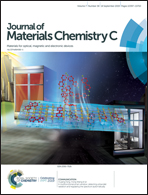Hydrophobic AgNPs: one-step synthesis in aqueous solution and their greatly enhanced performance for SERS detection†
Abstract
A hydrophobic surface can condense target analytes into hot-spot regions on a surface-enhanced Raman spectroscopy (SERS) substrate and be helpful in enhancing the SERS performances. Herein, hydrophobic AgNPs (o-AgNPs) were synthesized in one step for the first time in an aqueous solution at ambient conditions, which can be used for constructing hydrophobic SERS substrates on Cu(OH)2 nanowires (o-AgNPs/Cu(OH)2NWs). By using Rhodamine 6G (R6G) as a model, the o-AgNPs/Cu(OH)2NWs exhibit greatly enhanced sensitivity to R6G with a lower detectable concentration of 10−11 M. This enhancement mechanism can be attributed to the hydrophobic concentration effects of o-AgNPs, which can condense the analytes to their hot-spot, and thus enhance the SERS signals. In addition, the stability and reusability of the SERS substrate in aqueous solution are also improved. This universal and simple strategy for the construction of a SERS substrate with hydrophobic nanoparticles will certainly show great potential applications in many fields for trace detection.



 Please wait while we load your content...
Please wait while we load your content...